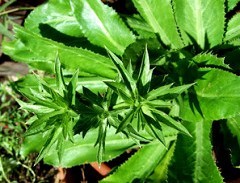Culantro
(Eryngium aquaticum)

Description
Eryngium foetidum is a tropical perennial herb in the family Apiaceae. Common names include culantro (/kuːˈlɑːntroʊ/ or /kuːˈlæntroʊ/), recao, shadow beni, Mexican coriander, bhandhania, long coriander, sawtooth coriander, and ngò gai. It is native to Mexico, the Caribbean, and Central and South America, but is cultivated worldwide, mostly in the tropics but sometimes being grown as an annual in temperate climates. In the United States, the common name culantro sometimes causes confusion with cilantro, a common name for the leaves of Coriandrum sativum (also in Apiaceae), of which culantro is said to taste like a stronger version. Eryngium foetidum is widely used in seasoning, marinating and garnishing in the Caribbean, particularly in Cuba, the Dominican Republic, Puerto Rico, Trinidad and Tobago, Panama, Costa Rica, Guyana, Suriname, and in Ecuador and Peru's Amazon regions. It is used extensively in Cambodia, Thailand, India, Vietnam, Laos, Myanmar, South-Western China and other parts of Asia as a culinary herb. It dries well, retaining good color and flavor, making it valuable in the dried herb industry. It is sometimes used as a substitute for coriander leaves, but has a much stronger taste. Eryngium foetidum has been used in traditional medicine in tropical regions for burns, earache, fevers, hypertension, constipation, fits, asthma, stomachache, worms, infertility complications, snake bites, diarrhea, and malaria. Eryngium foetidum is also known as E. anti
Taxonomic tree:







